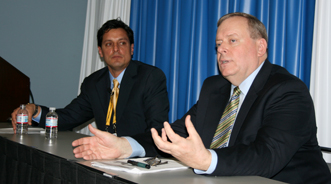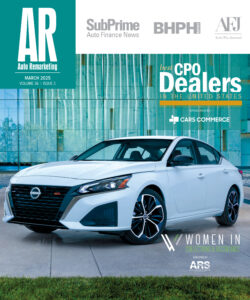NADA Used Car Guide: Auction Prices On Cusp of Another Full-Year Hike

Both Jonathan Banks, of NADA Used Car Guide, and Paul Taylor, the National Automobile Dealers Association’s economist, teamed up to give a special presentation on market trends this past weekend at the NADA convention.
Interestingly, Taylor pointed out that the lack of used cars is a source of strength for new car sales.
He explained, "More households are getting off the fence and buying new cars. They used to be used car purchasers but are now purchasing new."
Taylor went on to note that the average 3.2 percent depreciation in home equity has been a big driver in the downswing of new-car sales. However he, like many others in the industry, is predicting that the market has turned a corner. He believes the recovery of the world market conditions, as well as federal policies and stock market improvements, will help ramp up vehicle buying.
"There is clearly an increase in household wealth, and that is leading to such purchases as luxury cars," Taylor highlighted. "Increasing gas prices, however, does cause consumers to look at all types of vehicles."
Basically, as gas prices climb, he said it will take a shorter period for the higher cost of hybrids to be paid off, and he believes consumers could realize this.
Taylor also joked that the large elephant in the room is the government deficit. He said it will be interesting to see how this is addressed in the coming months and years and what impact this could have on consumer spending.
Ultimately, Taylor said, "We’ll see 16 million in sales again, it just won’t be next year."
Next up, Banks took the spotlight discussing used-vehicle trends. He kicked off his portion of the presentation by saying that automakers are really starting to clue into the fact that high incentives hurt resale and residual values. By keeping incentives low, he said the automakers are "improving consumer perception of high quality cars."
He also noted that there is "probably more of an opportunity for luxury prices to improve."
While used-vehicle volumes tend to be low at auctions, Banks said the aggressive bidding by dealers on available units is ramping up the prices. This has caused the margin between new-vehicle prices and used prices to shrink. When new-car sales plummeted in 2009, he said franchised dealers flocked to auctions to drive up their stock of used vehicles and increase these sales. That is what initially led to wholesale prices growing so quickly.
Another key point Banks shared was that this economic downturn is an opportunity for dealers to invest more in improving the services offered to customers.
"The used side of the business has become as important as the new-car side. Dealers want and need those trade-ins. They are getting high-quality used vehicles and are not sending these vehicles to auction as much," Banks stressed.
He also credits dealers with getting on the Generation Y bandwagon and learning how to best cater to these customers.
Credit availability is also playing a role in bolstering the market, Taylor and Banks agreed. Consumers with prime and near-prime credit are having less problems getting financed. However, at the other end of the spectrum, the executives noted that it is still difficult to get the subprime customer financed.
In response to this, many franchised dealers are getting into the buy-here, pay-here business. According to Banks, dealers are basically hoping to turn these credit-challenged consumers into customers for life. Dealers tend to think if they can help out a customer when his credit is hurting, the individual will keep coming back for each subsequent vehicle purchase until the customer improves his credit enough to buy new, the executive highlighted.
NADA Used Car Guide Releases Regular Update
Looking at the data revealed in its most recent market report, the company found that the increases used-vehicle prices during 2010 continued to build upon the rapid gains from the prior years, and while other analysts may suggest differently, NADA Used Car Guide believes this wholesale surge will continue during 2011.
This was just one of several findings detailed by analysts in the latest Guidelines report from NADA Used Car Guide.
Breaking down some of the findings, AuctionNet data indicates that two- to five-year-old trucks and SUVs showed 10- to 15-percent used-price gains during 2010, while the same age group of cars climbed between 5 and 10 percent.
In 2009, trucks jumped in the 30-to-38 percent range and cars climbed 19 percent.
During last year, the wholesale improvement for domestics was between 10 and 15 percent on average, and import values jumped approximately 10 percent, on average, compared to 2009.
That said, Kia and Mazda, for instance, showed larger-than-average wholesale price increases.
Similar to their counterparts on the non-luxury side, the wholesale values of luxury makes were ahead of the prior-year level. Wholesale price gains of at least 10 percent were spotted in high-volume luxury brands, among those being Audi, BMW, Cadillac, Lexus and Mercedes-Benz, officials indicated.
“So what does this all mean for the used market in 2011? We believe that the factors detailed above will support strong auction prices and we foresee used prices continuing to increase throughout 2011,” the report stated.
“Some analysts have suggested that used values will experience a downward ‘correction’ since they are at historically high levels,” officials noted. “NADA does not believe this will occur; in fact, when looking at auction price performance and adjusting for the prices of goods in general, used-vehicle values are really more in line with historical price performance.”
NADA projects a 5- to 10-percent hike for used prices for full-year 2011.
The used-to-new price ratio has also been cause for some worry, officials noted. However, it is not as dramatic as it may seem on the surface, they pointed out.
“Although used prices as a percentage of new prices are significantly higher today than they were at the height of the recession, they are only (approximately) 2.5 percent higher than where they were in January 2006, and (approximately) 5 percent higher than the five-year average,” analysts explained.
“However, considering that the quality, design and technology of vehicles have improved so dramatically during the past few years, and new vehicle production is at historically low levels, there is an opportunity for new prices to continue to increase, which actually creates a halo effect for used prices,” they added.
NADA Used Car Guide also indicated that there was a 5-percentage-point drop in the average premium between wholesale and retail prices that occurred in 2008. In the years since then, the premium has been consistent. As most know, with new car sales dropping, dealers focused more on used sales at that time, so this was not a surprise.
“However, this is also the result of a more transparent environment where price information is widely understood by dealers, manufacturers and consumers, which removes the ability to price based on the asymmetry of price information,” officials pointed out.
“As price information becomes more standardized, profit margins will decrease on a per unit basis, but volume and turn rates should benefit positively,” they added.
“On the bright side, even though used wholesale price increases have pushed closer to retail used prices, many dealers are still able to record healthy profits on the used side,” analysts continued.
Citing NADA 20 Group data, officials indicated that November’s gross used margins came were up 2 percent at 13.6 percent. Analysts credited “improvements in inventory management, financing and incremental add-ons to the vehicle purchase” for this upswing.
Moving along, NADA Used Car Guide also shared AuctionNet data for January.
According to its data, AuctionNet prices were up sequentially and year-over-year for all five segments included in the analysis.
Looking first at year-over-year trends the increases ranged from 7.6 percent to 11 percent. Car prices climbed about 8 percent and the CUV gain was slightly behind that of the cars. Meanwhile, price gains for pickups, SUVs and vans all exceeded 10 percent from January 2010.
Compared to December, car prices climbed around 1 percent and CUVs were up more than 0.8 percent.
Pickup prices climbed more than 1 percent (but less than 1.2 percent) while SUV prices improved almost 0.6 percent. Values for vans jumped more than 1.6 percent from December.
—Auto Group Editor Jennifer Reed contributed to this article.

 View The Latest Edition
View The Latest Edition

